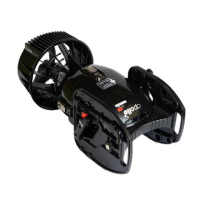Speed upUpturn
● The force of positive buoyancy● The power generated
by the scooter
● Diver's negative buoyancy
Direction
Riding at the water's surface is also possible with the scooter. By wearing equipment designed for skin
diving (mask, snorkel, and fins, and appropriate amount of weight on the hips), the diver can easily move around
the water's surface.
When riding at slow-speed, it is necessary to
adjust your buoyancy slightly using a buoyancy
compensator (B.C.).
In doing so, the diver's legs will sink due to the
weight of the scooter, making the upper body rises
up slightly.
In order to balance out the upward force caused
by the lowering of the scooter and the diver's
negative buoyancy, the revolution speed of the
propeller and the angle of the scooter must be
adjusted.
Making turns using the body to help steer is not as effective when riding at low-speed.
To make a left or right turn, lean the upper body while in an up upright angle / position in the direction of the turn,
and the scooter itself will begin to move in that direction.
■ Surface riding
■ Slow speed riding (propeller pitch = 2 or 3 ; accelerator position = 4 - 6)
Riding
Normal riding Back riding Head first riding
Pay attention of
equalizing ears !
29

